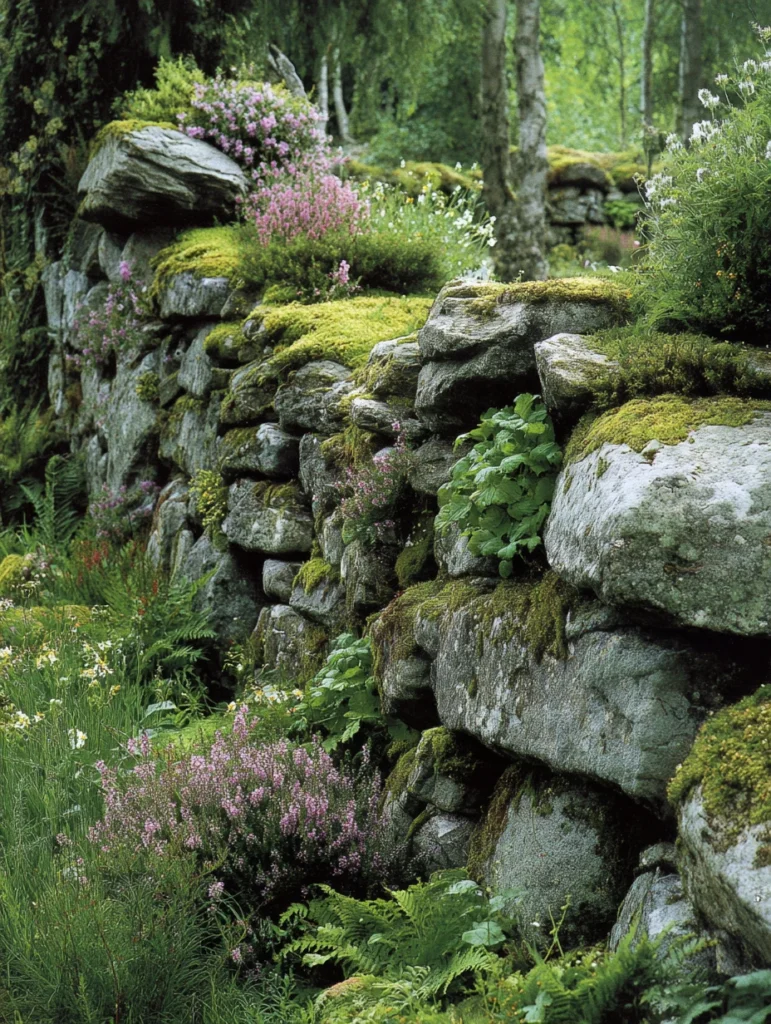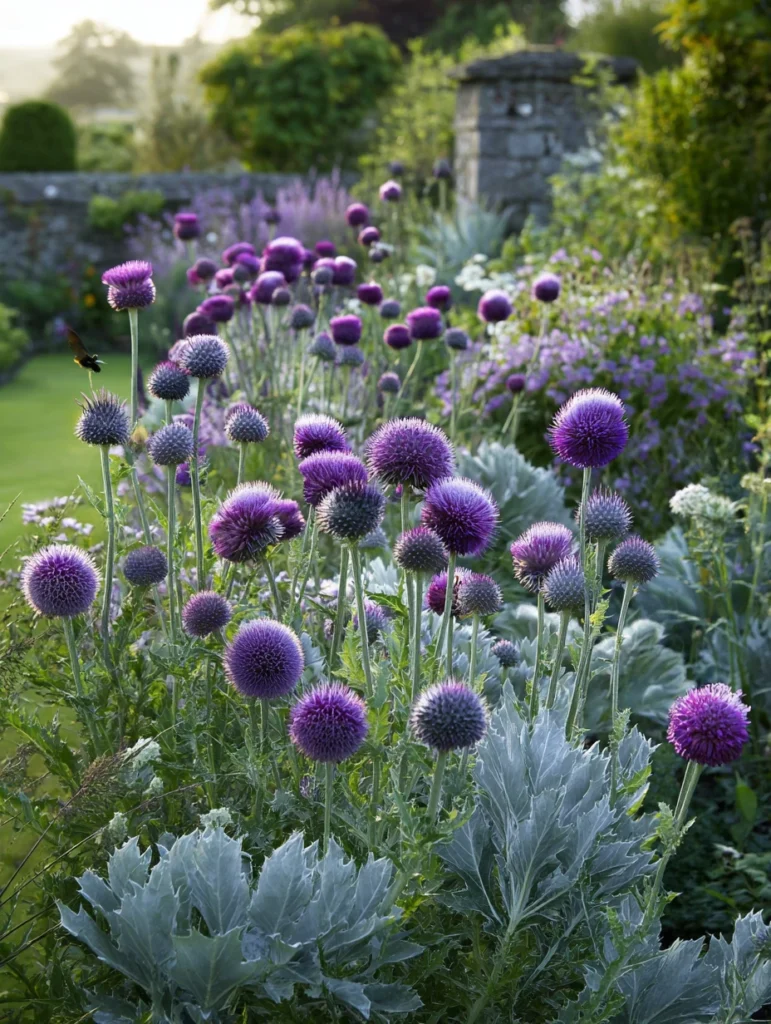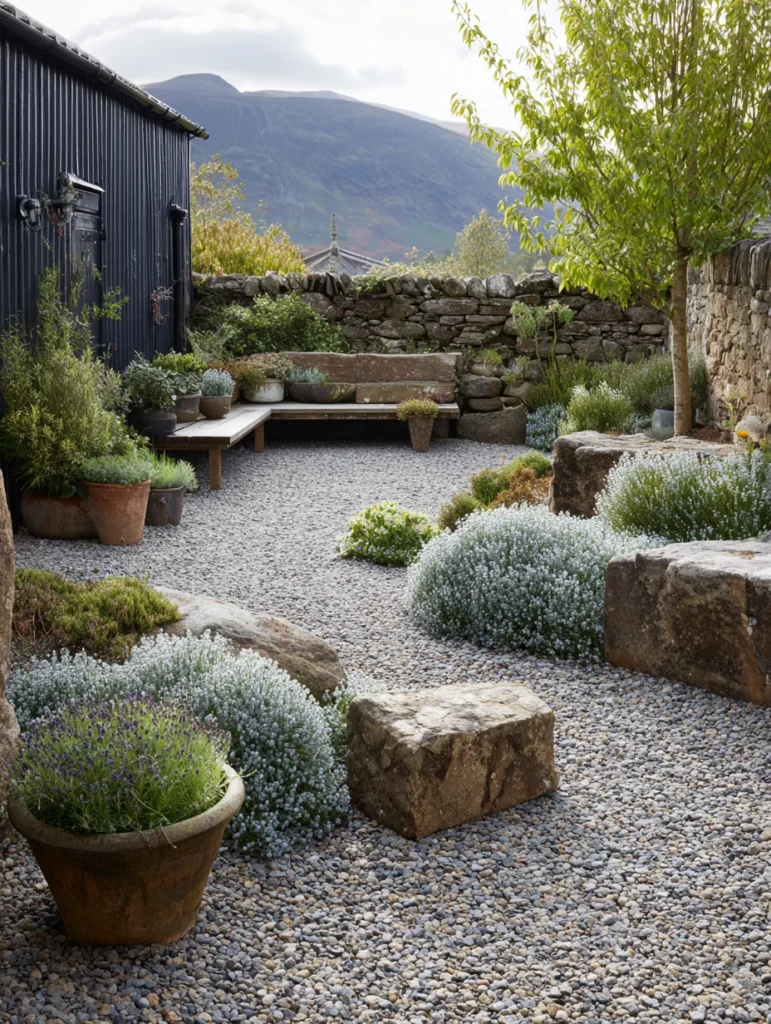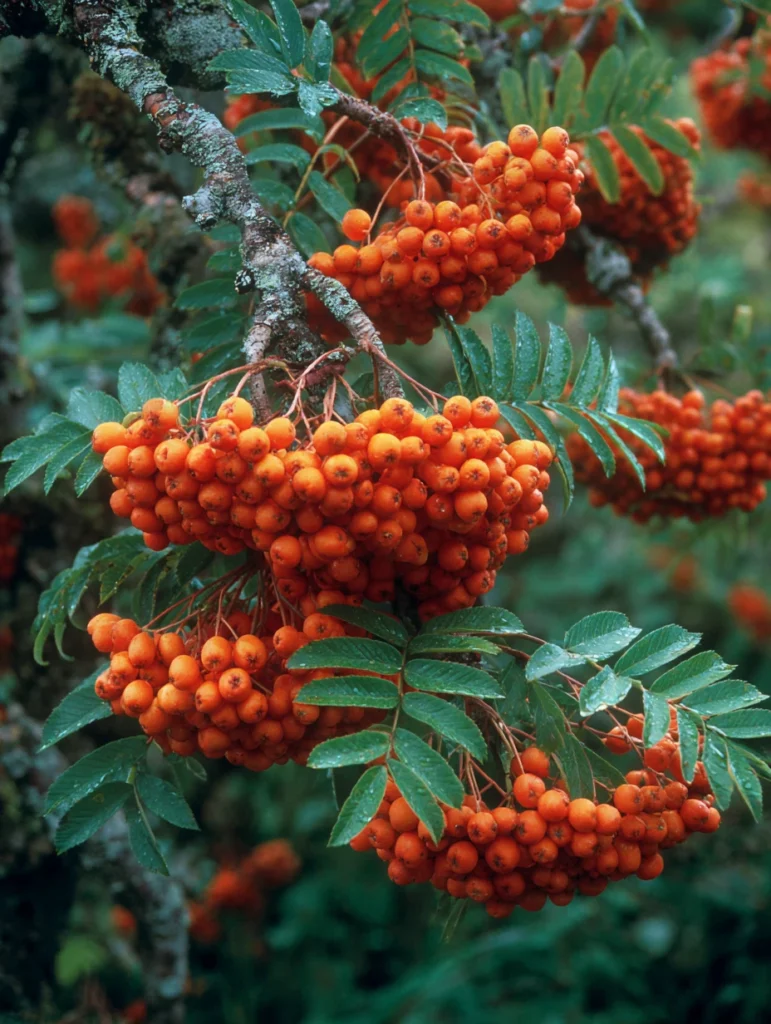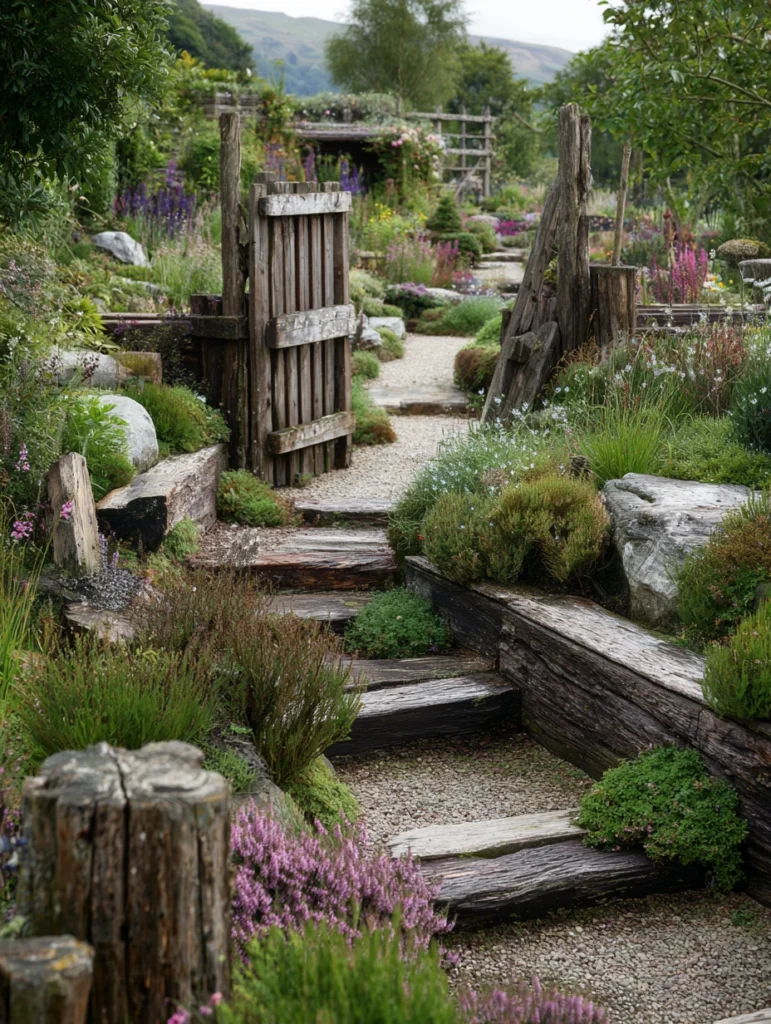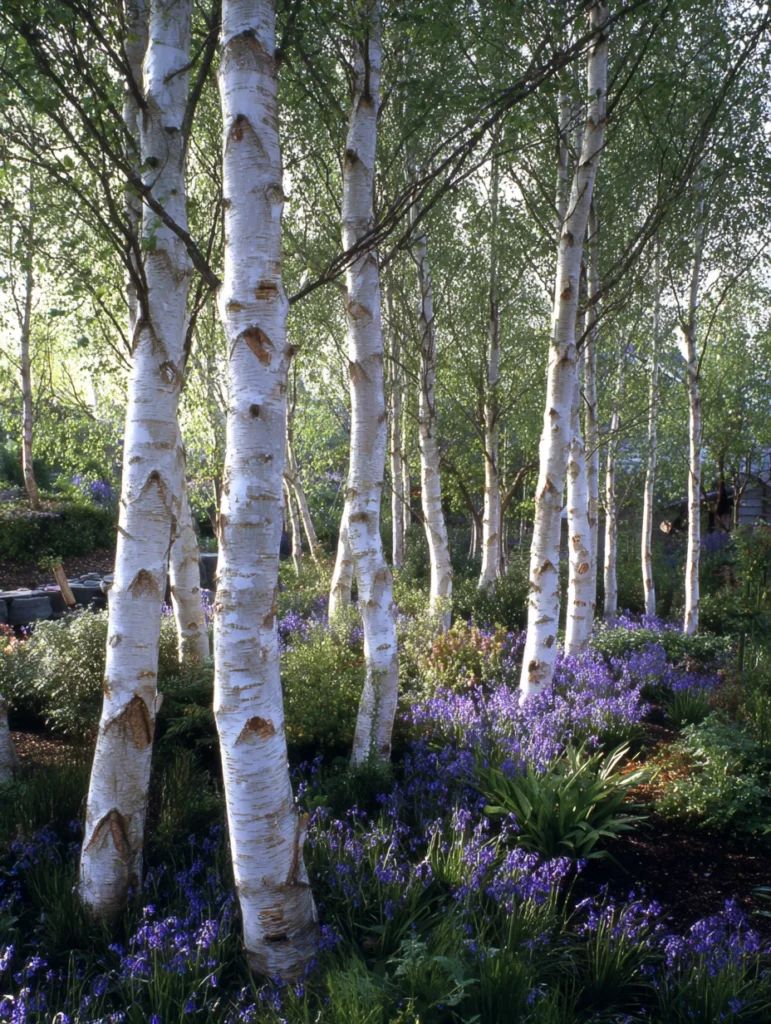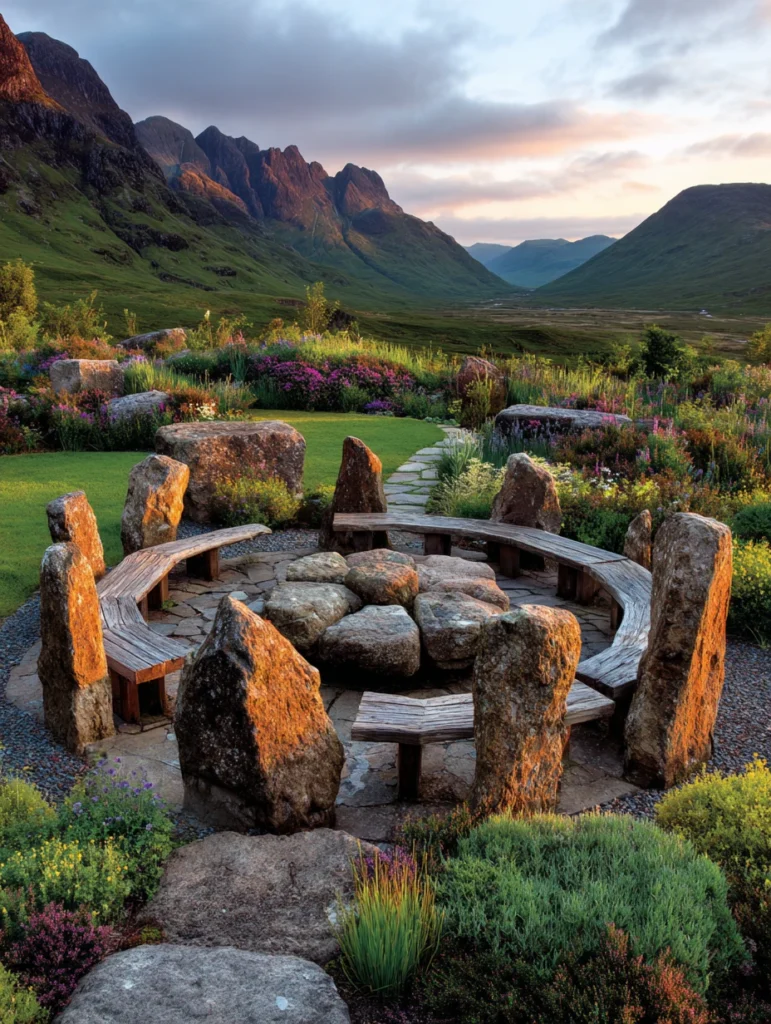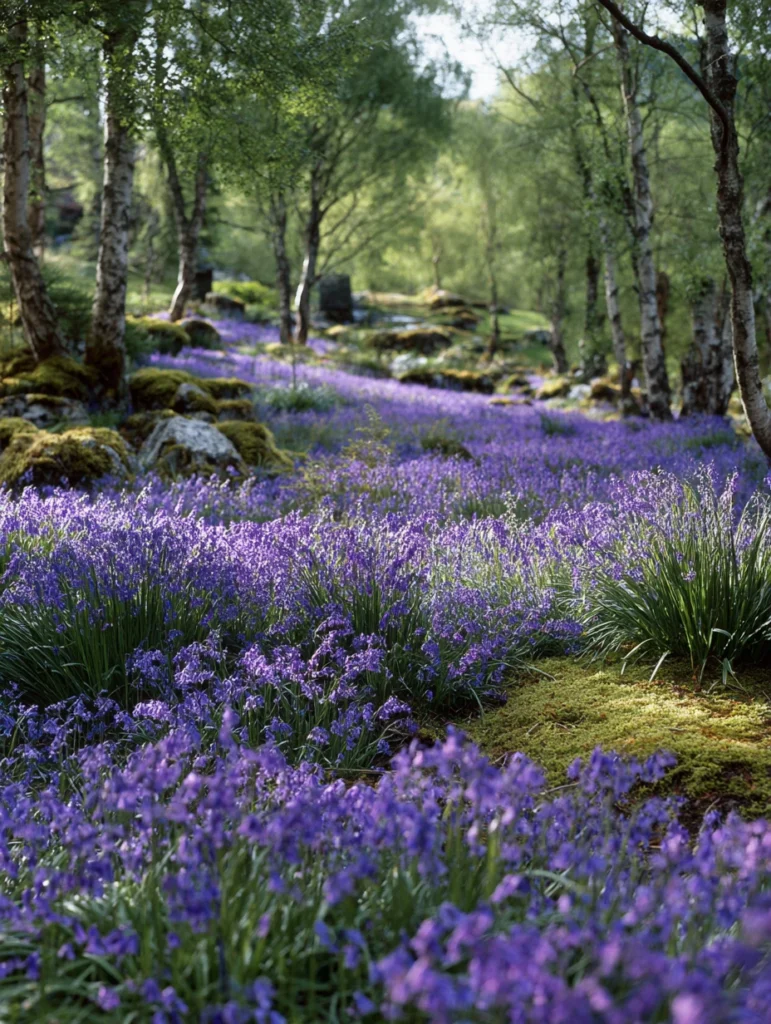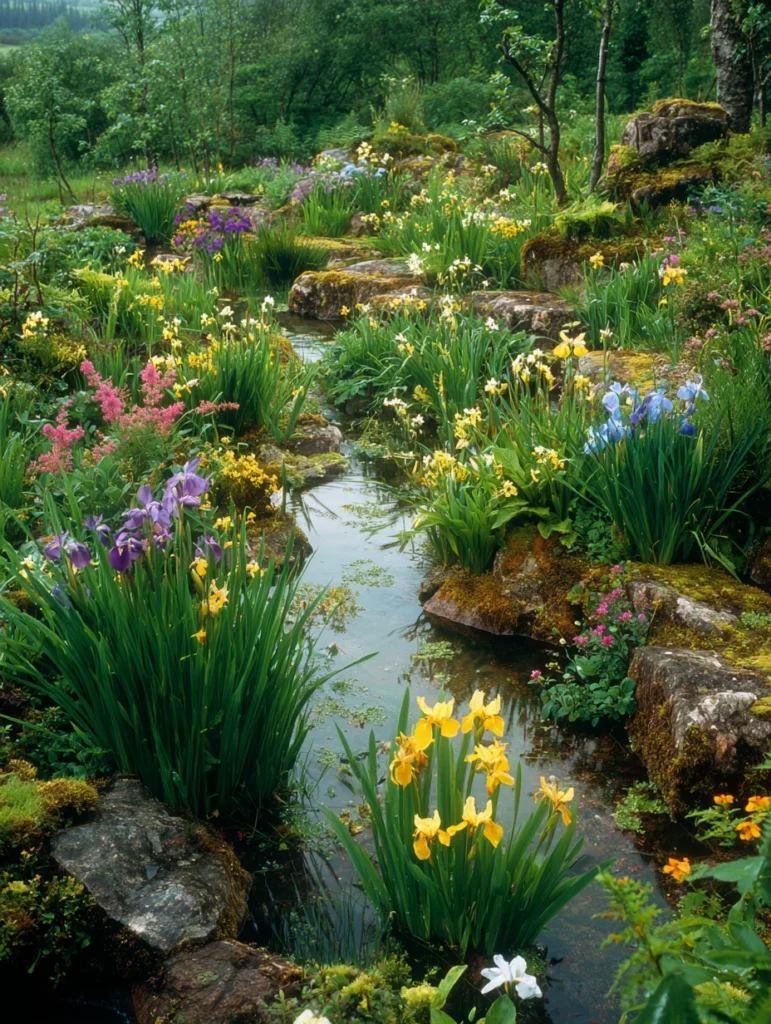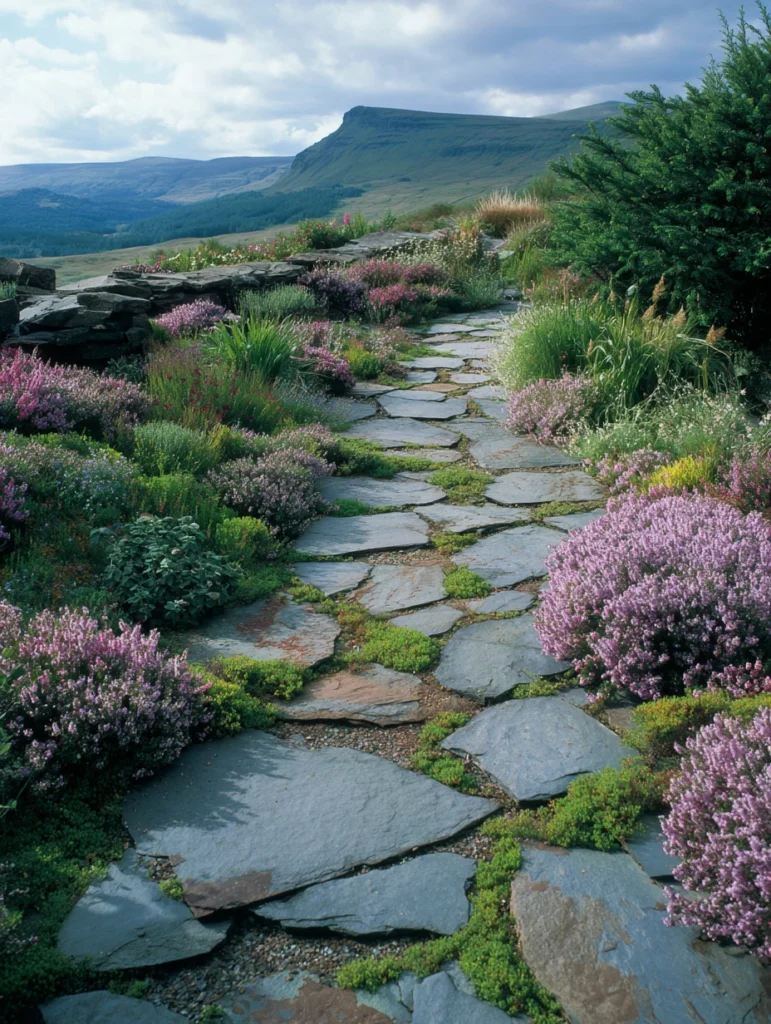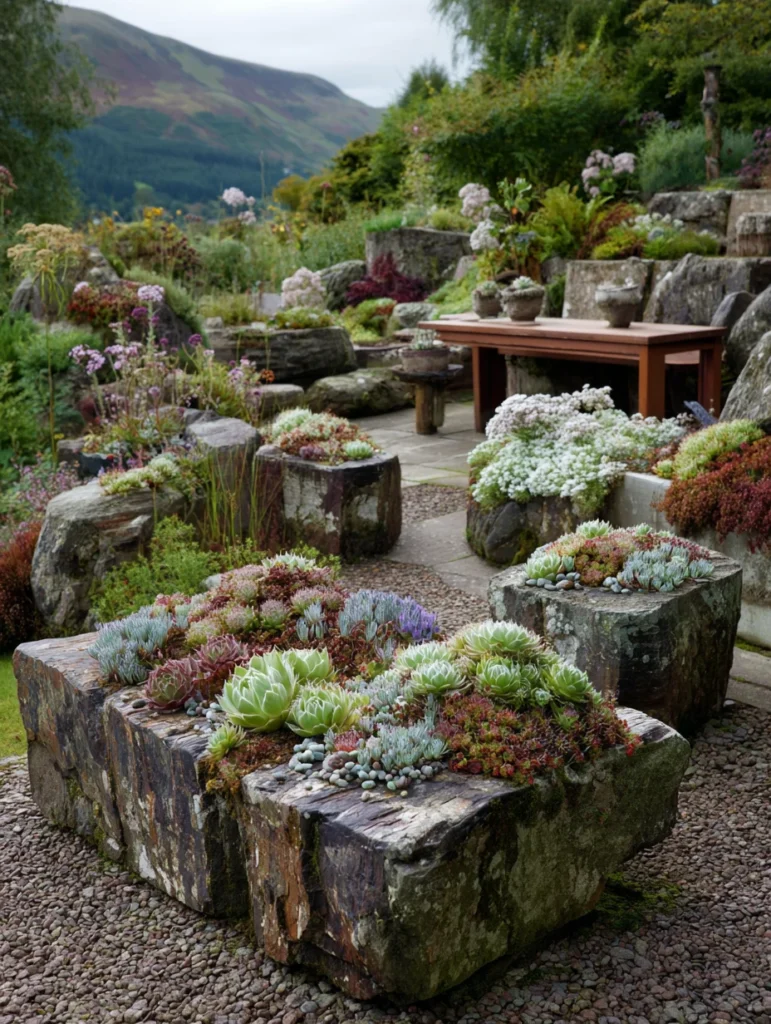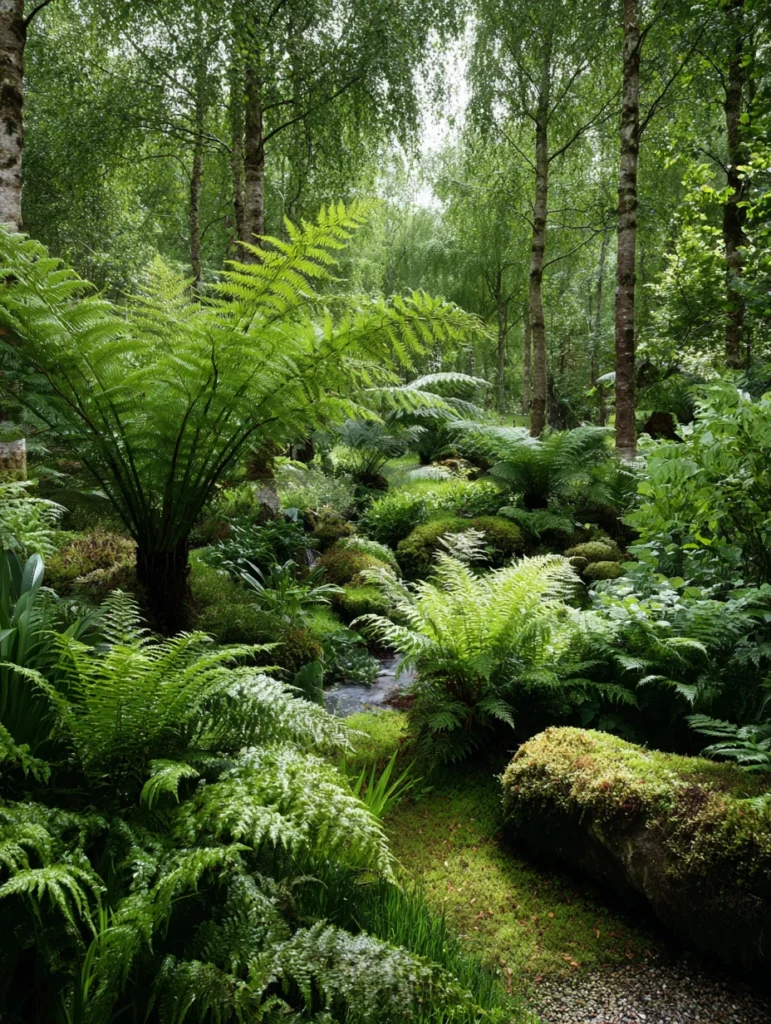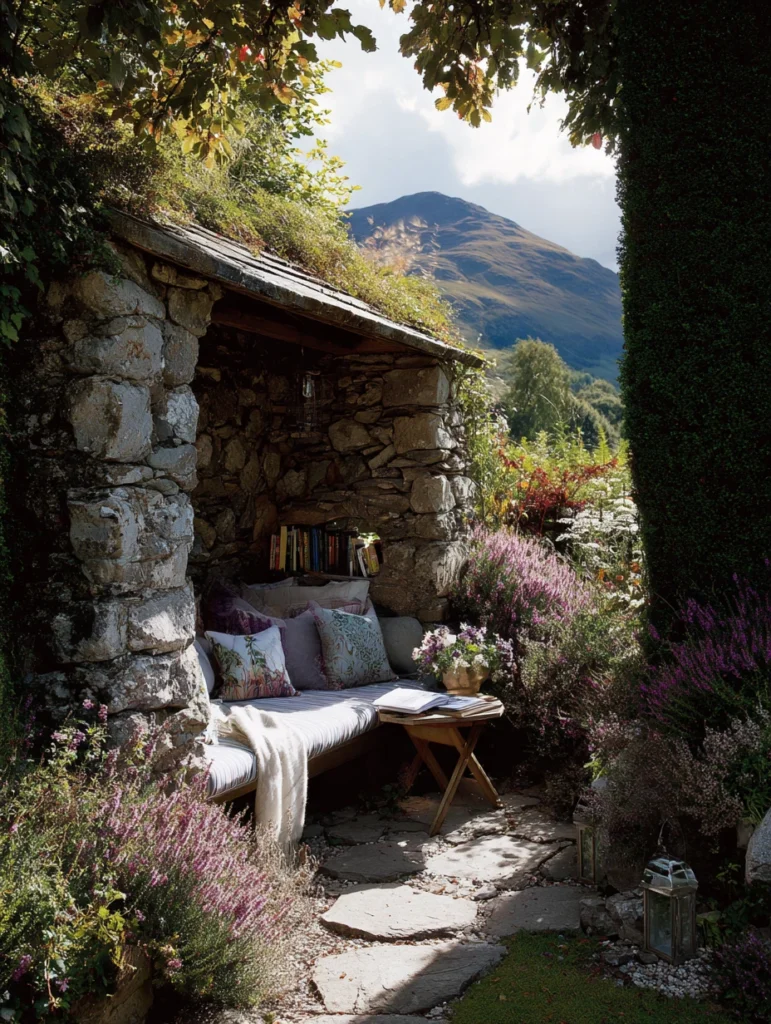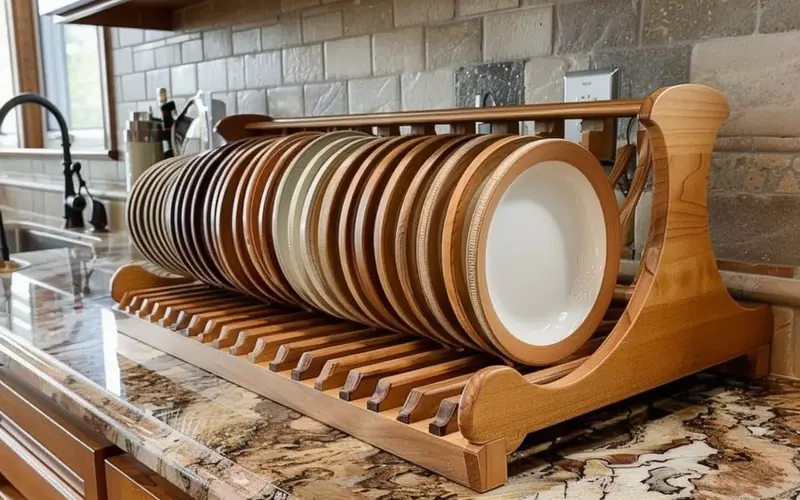Picture this – rolling hills carpeted in purple heather, ancient stone walls, and gardens that seem to grow straight out of the rugged landscape. Scottish Highland gardens possess a magical quality that makes you feel as though you’ve stepped into another world. I’ve always been fascinated by how these gardens manage to look both wild and intentional at the same time.
Whatever it is, bringing that Highland spirit into your own garden doesn’t require moving to Scotland (though that would be nice). You just need to understand what makes these gardens tick – the textures, the colors, the relationship with nature. Ready to transform your outdoor space into a Highland retreat? Let’s explore some ideas that’ll make your neighbors wonder if you’ve got Scottish roots.
1. Create a Purple Heather Carpet
Embrace the Iconic Highland Color: Heather is basically the celebrity of Scottish gardens. This low-growing evergreen shrub creates those stunning purple carpets you see across the Highlands. I plant mine in groups rather than scattering them around – it establishes that sweeping effect you’re after. Heather loves acidic soil and full sun, making it perfect for tricky spots where other plants struggle.
Layer Different Varieties: Not all heather blooms at the same time, which is your secret weapon. Mix Calluna vulgaris with Erica carnea for year-round interest. Some varieties have golden foliage, others lime green, and some retain a deep purple hue even when not in bloom. This keeps your garden from looking flat or one-dimensional.
Product Spotlight: The Scotts Turf Builder Lawn Soil works wonderfully for preparing acidic beds where heather thrives. For establishing new plants, the Espoma Organic Holly-tone Fertilizer provides the acidic boost these plants crave. Both help create that authentic Highland growing environment.
Read More: 21 Inspiring Vegetable Garden Design Ideas
2. Build Dry Stone Walls
Master the Ancient Craft: Dry stone walls are everywhere in Scotland, using no mortar – just careful stone selection and placement. Start small with a low garden border before tackling any structural changes. The key is finding stones that fit together naturally, creating a jigsaw puzzle effect. Flat rocks work best for the top and bottom layers.
Create Microclimates: Those gaps between stones are perfect homes for tiny alpine plants, ferns, and moss. The wall itself provides shelter and creates different growing conditions on each side. I’ve seen entire ecosystems develop within these walls – lizards sunbathe, small birds nest in crevices, and delicate plants find their perfect spot.
Product Spotlight: The DEWALT 20V MAX Cordless Hammer Drill makes drilling pilot holes in tougher stones much easier when you need to adjust positioning. The Ironclad Heavy Utility Work Gloves protect your hands during the intensive stone-handling process. Trust me, your hands will thank you.
Read More: 21 Small Zen Garden Ideas for a Tranquil Home
3. Plant a Wild Thistle Border
Celebrate Scotland’s National Flower: Thistles get a bad rap, but Scottish varieties are actually stunning garden plants. The purple blooms are architectural masterpieces, featuring spiky, silver-green foliage that adds serious drama. Globe thistle (Echinops) is my go-to because it’s less aggressive than wild varieties. Plant them at the back of borders where their height makes a statement.
Attract Wildlife Naturally: Goldfinches absolutely love thistle seeds, and you’ll spend hours watching them. Bees swarm the purple flowers during summer bloom time. The spiky texture also provides shelter for beneficial insects. It’s basically a wildlife buffet that looks gorgeous.
Product Spotlight: The Burpee Echinops Ritro Globe Thistle Seeds give you the Scottish look without the invasive spreading. Jobe’s Organics All-Purpose Fertilizer Spikes feed these heavy feeders throughout the growing season without requiring constant attention. Simple and effective.
Read More: 21 Cottage Garden Ideas for a Whimsical Space
4. Design a Gravel Courtyard Garden
Embrace Minimalist Hardscaping: Scottish courtyards often feature crushed stone or gravel instead of traditional paving. This creates excellent drainage and that characteristic Highland crunch underfoot. I use pea gravel in warm gray tones to mimic the look of Highland stone. It’s easier to install than pavers and costs less as well.
Add Strategic Planting Pockets: Cut out sections of gravel to create designated planting areas, rather than covering the entire region. This gives you controlled spaces for herbs, low-growing alpines, or small shrubs. The contrast between planted areas and gravel creates visual interest. Plus, weeding is way easier when plants are contained.
Product Spotlight: The Vigoro Bagged Pea Gravel provides that authentic Scottish stone appearance in a manageable size. The Dewitt Pro-5 Weed Barrier Fabric underneath prevents weeds while allowing proper drainage. Both are essential for a low-maintenance courtyard that looks intentional.
Read More: How to Design a Container Garden for Your Flowers
5. Incorporate Rowan Trees
Plant a Sacred Highland Tree: Rowan trees (mountain ash) are legendary in Scottish folklore and absolutely stunning in gardens. They stay relatively compact, produce white spring flowers, and develop bright orange berries by fall. The autumn colors are phenomenal – the leaves turn golden yellow, and those berries practically glow. Birds feast on the berries through winter.
Position for Maximum Impact: I plant rowans as specimen trees near seating areas where you can enjoy their seasonal show. They handle exposed sites brilliantly, which makes sense given their Highland origins. The delicate foliage casts dappled shade without blocking too much light. Perfect for underplanting with spring bulbs.
Product Spotlight: The Arbor Day Foundation Tree Fertilizer Spikes help young rowans establish strong root systems. The Fiskars Steel Bypass Pruning Shears make annual maintenance pruning quick and clean. These trees are forgiving, but proper care helps them thrive.
Read More: Amazing Herb Garden Ideas for Your Outdoor Oasis
6. Add Weathered Wooden Features
Choose Rustic Materials: Weathered wood adds that lived-in Highland character that feels authentic. I use reclaimed railway sleepers for raised beds and old fence posts for garden edging. The silvery-gray patina develops naturally over time. Don’t fight it – that aged look is precisely what you want.
Create Functional Art Pieces: Old wooden ladders make fantastic plant displays, and vintage gates become garden features. Stack weathered crates for vertical herb gardens. The key is to ensure everything looks cohesive, not like you raided a flea market. Each piece should serve a purpose.
Product Spotlight: The Thompson’s WaterSeal Advanced Natural Wood Protector helps preserve reclaimed wood without hiding its character. The Mouse Detail Sander smooths rough edges on salvaged pieces safely and efficiently. Both extend the life of weathered wood features considerably.
Read More: 21 Corner Garden Ideas to Transform Your Backyard
7. Establish a Moss Garden
Grow Scotland’s Green Carpet: Moss thrives in Scotland’s damp climate, creating an ancient, timeless feel. It’s perfect for shady spots where grass struggles. I encourage moss growth rather than fighting it – less mowing, more character. Moss stays green year-round and feels amazing underfoot.
Maintain Proper Conditions: Moss loves shade, moisture, and slightly acidic soil. Remove competing weeds, but allow moss to spread naturally. You can even transplant moss patches from one area to another. Mist it during dry spells to keep it lush. It’s surprisingly low-maintenance once established.
Product Spotlight: The Espoma Organic Soil Acidifier creates ideal conditions for moss establishment. The Gilmour Thumb Control Watering Nozzle allows you to gently mist moss without washing it away. Both tools help cultivate that authentic Highland moss carpet.
Read More: Stunning Flower Bed Ideas for the Front of the House
8. Plant a Birch Grove
Create White-Barked Drama: Silver birch trees with their distinctive white bark are Highland classics. Plant them in groups of three or five for that grove effect. The peeling bark adds winter interest when everything else looks dormant. Their delicate leaves create beautiful dappled shade that moves with the breeze.
Underplant with Woodland Favorites: Birches have shallow roots that allow underplanting with ferns, hostas, and spring bulbs. The filtered light creates ideal conditions for shade lovers. I plant bluebells underneath for spring color, then ferns take over for summer. It’s a self-sustaining mini ecosystem.
Product Spotlight: The Jobe’s Tree & Shrub Fertilizer Spikes feed birches without complicated measuring. The Forged Bypass Hand Pruner handles the light pruning birches occasionally need. Simple maintenance keeps these beauties healthy.
Read More: 17 Garden Ideas for Small Spaces and Maximum Yield
9. Design a Stone Circle Sitting Area
Echo Ancient Standing Stones: Create your own miniature stone circle as a garden focal point. Use large upright stones arranged in a circle around a central seating area. It doesn’t need to be Stonehenge-sized – even a modest circle creates that mystical Highland vibe. Position it where you can enjoy garden views.
Add Comfortable Seating: Place weathered wooden benches or flat stones for seating inside your circle. I surround mine with low-growing thyme that releases fragrance when stepped on. The rocks absorb heat during the day and radiate it back at night. It’s surprisingly cozy for evening relaxation.
Product Spotlight: The Stonehaven Outdoor Waterproof Cushions add comfort to stone seating without clashing with the rustic aesthetic. The Coleman Camping Chairs provide portable seating when you need extra spots. Both maintain the outdoor, rugged Highland feel.
Read More: How To Create a Beautiful Rose Garden To Inspire You
10. Grow Scottish Bluebells
Plant Native Spring Bulbs: Scottish bluebells carpet Highland woodlands each spring with their nodding purple-blue flowers. They naturalize beautifully, spreading slowly to create those dreamy carpets you see in photos. Plant them under trees or shrubs where they’ll get spring sun but summer shade. The fragrance is intoxicating.
Let Them Self-Seed: Bluebells are best left undisturbed once planted. They’ll self-seed and spread naturally over time. Don’t deadhead – let the seed pods mature and scatter their seeds. Within a few years, you’ll have that authentic woodland floor. The foliage dies back neatly by midsummer.
Product Spotlight: The Van Zyverden Dutch Bluebell Bulbs provide the authentic Scottish woodland effect at planting time. The Fiskars Bulb Planter makes installing dozens of bulbs much easier on your back and knees. Both are essential for creating those spectacular spring displays.
Read More: 21 Japanese Garden Ideas for Serene Outdoor Spaces
11. Create a Peat-Free Bog Garden
Design for Wet Areas: The Scottish Highlands have plenty of boggy areas, and you can recreate this in low-lying spots. Bog gardens support unique plants that love constantly moist soil. Dig out an area, line it with punctured liner, and backfill with peat-free compost. It’s like creating a specialized habitat.
Choose Moisture-Loving Plants: Iris, primula, and astilbe thrive in bog conditions. Their vibrant colors contrast beautifully with darker foliage. Add some marsh marigolds for early spring color. These gardens require less watering than traditional beds since they hold moisture naturally.
Product Spotlight: The Proven Winners ColorChoice Astilbe offers reliable color in the bog garden throughout the summer months. The Gardener’s Supply Company Soaker Hose maintains consistent moisture levels during drier periods. Both help your bog garden flourish year-round.
Read More: 21 Stunning Mediterranean Garden Ideas To Inspire You
12. Install a Slate Path
Choose Highland Stone: Slate is mined in Scotland, creating authentic-looking paths that age beautifully. The blue-gray tones complement every plant color. I lay mine in irregular patterns rather than straight lines – it looks more natural. Slate provides excellent grip even when wet.
Edge with Low Growers: Let creeping thyme, sedum, or Scottish moss soften the path edges. These plants naturally fill gaps between stones. The informal planting makes the paths look as if they’ve been there forever. Step on them occasionally to release their fragrance.
Product Spotlight: The Rain Forest Stepping Stones Natural Slate delivers that authentic Highland appearance in manageable sizes. The Vigoro All Purpose Sand creates a stable base and fills gaps between stones. Both ensure your path looks professional and lasts.
Read More: How To Create an English Cottage Garden for Your Flowers
13. Add a Small Water Feature
Incorporate Highland Streams: A simple stone-lined channel or small fountain evokes Highland burns (streams). The sound of water adds tranquility and attracts birds. I keep mine small and naturalistic – no elaborate fountains that look out of place. Use local stones to line the edges.
Plant Water-Loving Perennials: Surround your feature with ferns, iris, and moisture-lovers. This integration makes it look like a natural spring rather than an add-on. Moss naturally colonizes the stones, adding to the aged appearance. Wildlife quickly discovers it as a drinking spot.
Product Spotlight: The Alpine Corporation Tiering Tabletop Fountain provides gentle water movement without overwhelming small spaces. The Aquascape Pond Pump circulates water efficiently for slightly larger features. Both create that soothing Highland stream atmosphere.
Read More: 21 Aesthetic Garden Ideas to Transform Your Outdoor Space
14. Grow Native Wildflowers
Embrace Natural Beauty: Scottish wildflower meadows burst with poppies, cornflowers, and ox-eye daisies. They’re tougher than fancy hybrids and need less coddling. I dedicate a section of lawn to wildflowers – less mowing, more color. Cut paths through it for a meadow-walk effect.
Time Your Mowing Correctly: Let wildflowers set seed before the first cut in late summer. This ensures they return next year. One or two cuts per year are sufficient to maintain the meadow without suppressing the flowers. It’s counterintuitive if you’re used to weekly mowing, but it works.
Product Spotlight: The Eden Brothers Scottish Wildflower Mix Seeds contains authentic Highland species in one package. The Scotts Turf Builder Grass Seed helps fill in paths through your meadow where you want maintained grass. Both create that wild-yet-intentional look.
Read More: How To Create a Magical DIY Fairy Garden for Your Backyard
15. Create Stone Troughs for Alpines
Showcase Miniature Landscapes: Stone troughs filled with alpine plants are a staple of Highland gardens. These containers provide ideal drainage for plants that dislike wet feet. I arrange mine near seating areas where you can appreciate the tiny plants up close. They’re living sculptures.
Layer for Drainage: Fill troughs with gravel at the bottom, then gritty alpine compost. Plant sempervivums, saxifrages, and tiny sedums. These tough plants handle exposure beautifully—Top-dress with small stones to complete the miniature mountain scene.
Product Spotlight: The Hoffman Cactus and Succulent Soil Mix provides excellent drainage for alpine plants. The Pennington Enriched Perlite improves any soil mix for better drainage. Both help recreate those well-draining Highland mountain conditions that alpines love.
Read More: Urban Gardening Solutions: Creating a Small Patio Veggie Garden
16. Plant a Hedge of Scottish Roses
Choose Hardy Varieties: Scottish burnet roses thrive in harsh conditions, boasting simple single flowers and vibrant orange hips. They’re tougher than fancy hybrid teas and look more natural. Plant them as informal hedges that provide privacy while feeding wildlife. The hip display lasts well into winter.
Allow Natural Form: Don’t over-prune these roses into formal shapes. Let them develop their natural arching habit. Light pruning removes dead wood, helping to maintain the plant’s size and shape. The relaxed form fits Highland garden aesthetics better than rigid formality.
Product Spotlight: The David Austin English Shrub Roses capture that old-world Scottish aesthetic with modern disease resistance. The Jobe’s Organics Rose & Flower Fertilizer feeds them naturally throughout the growing season. Both ensure healthy, floriferous plants.
17. Add Weathered Metal Accents
Incorporate Rusty Charm: Old metal tools, watering cans, and farm implements add authentic Highland character. I lean them against walls or hang them from hooks. The rust patina develops naturally and looks intentional. These pieces tell stories and add personality.
Create Functional Displays: Use old metal buckets as planters, vintage tools as trellises, and aged lanterns for ambient lighting. Everything should work with your garden’s overall style. Don’t overdo it – a few well-placed pieces beat cluttered randomness.
Product Spotlight: Miracle-Gro Indoor Plant Food keeps plants in repurposed metal containers healthy, even in unusual growing conditions. The Rust-Oleum Rust Reformer Spray stabilizes rust patina without removing character. Both help vintage metal features last.
18. Establish a Fern Grotto
Create Shaded Sanctuary: Scottish woodlands are thick with ferns, and you can recreate this in shady garden corners. Ferns thrive in moist, shady areas, making them ideal for problem spots. I plant several varieties together for textural interest. They stay green from spring through fall.
Layer Different Heights: Mix tall royal ferns with delicate maidenhair types and spreading bracken. This creates depth and makes the space feel larger. Ferns naturally look ancient and mysterious. Add some moss-covered logs for extra Highland atmosphere.
Product Spotlight: The American Plant Exchange Hardy Fern Collection offers a diverse selection without the need to search multiple sources. The Osmocote Smart-Release Plant Food feeds ferns steadily without burning delicate fronds. Both help create that lush grotto effect quickly.
19. Design a Tartan-Inspired Planting Scheme
Work with Pattern Colors: Use plants in colors that echo traditional tartans—deep purples, forest greens, burgundy reds, and cream whites. Arrange them in blocks or stripes for a visually striking effect. It’s a fun way to subtly incorporate Scottish heritage. The effect is striking without being literal.
Choose Reliable Performers: Purple salvia, red astilbe, cream irises, and green hostas create a reliably vibrant palette. They bloom at different times, maintaining interest through seasons. I plant in drifts rather than single specimens for better color impact.
Product Spotlight: The Proven Winners Salvia Collection provides reliable purple tones throughout summer. The Breck’s Iris Bulb Collection features cream and white accents that stand out against darker colors. Both deliver that tartan-inspired palette beautifully.
20. Create a Sheltered Reading Nook
Build Wind Protection: Highland gardens need shelter from constant wind. Create a tucked-away corner using stone walls, hedges, or wooden screens to create a serene and private space. Add comfortable seating where you can actually relax without getting windblown. I surround mine with fragrant plants for sensory enjoyment.
Add Cozy Elements: Weatherproof cushions, outdoor blankets, and solar lanterns make the space inviting. Keep it simple but comfortable. The goal is a spot where you’ll actually spend time, not just photograph. Position it to catch the afternoon sun.
Product Spotlight: The Hampton Bay Outdoor Solar LED String Lights add evening ambiance without the need for electrical work. The Classic Accessories Ravenna Patio Cushions provide weather-resistant comfort. Both transform a simple nook into your favorite garden retreat.
21. Plant a Kitchen Herb Garden
Grow Traditional Scottish Herbs: Rosemary, thyme, chives, and parsley all thrive in Highland conditions. Plant them in raised beds, containers, or dedicated garden patches. Fresh herbs elevate your cooking while adding a beautiful touch. The bonus? They’re mostly deer-resistant.
Design for Easy Access: Position your herb garden near the kitchen door for convenient harvesting. I use a mix of permanent woody herbs and annual replants. Stone or gravel paths between beds keep feet dry during harvest. It’s both practical and attractive.
Product Spotlight: The Back to the Roots Organic Herb Garden Kit provides a quick start with essential herbs. The Gardener’s Blue Ribbon Ultomato Tomato and Vegetable Plant Cage supports taller herbs, such as rosemary, through windy weather. Both help establish a productive Highland kitchen garden.
Final Thoughts
There you have it – 21 ways to bring Highland magic into your garden without booking a flight to Scotland. The beauty of these ideas lies in their adaptability. You don’t need acres of land or a massive budget to capture that rugged, romantic Highland spirit. Start with one or two elements that speak to you – maybe a heather bed or some weathered wood features.
Let your garden evolve naturally, adding pieces as you go. The best Highland gardens appear unforced, as if they have grown organically over time. Maybe grab a cup of tea and spend some time just sitting in your space, planning which idea to try first. What element of Highland beauty calls to you most?


